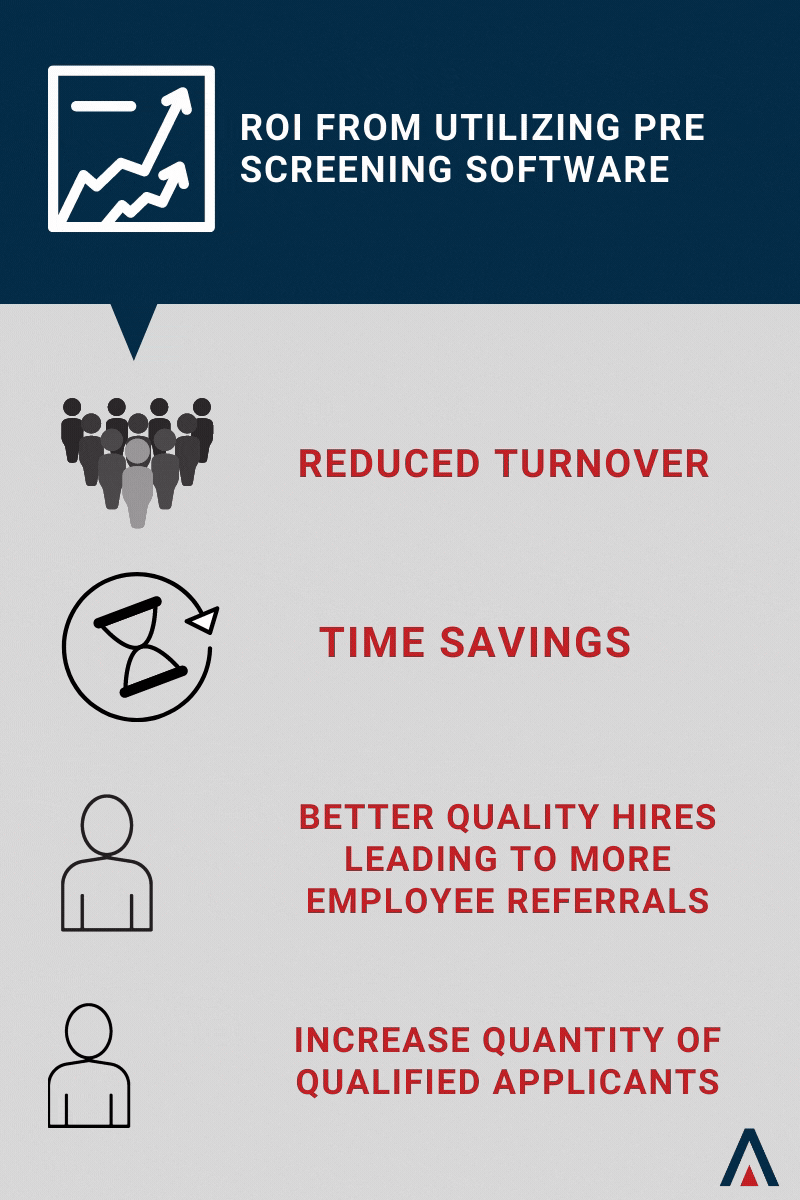Table of Contents
The Ultimate Pre-employment Screening Guide
Pre-employment screening tools and techniques have been around for many years, however, it is now becoming more important and therefore more commonplace in today’s hiring process. Companies are learning that using pre-employment screening tools can drastically effect efficiency and effectiveness of hiring, especially in high-volume hiring positions and seasonal hiring situations. There are many different ways of screening applicants – this page is dedicated to helping you learn everything you need to know about pre employment screening and how it makes sense for your business. For the purpose of this page we are making a distinction between pre-screening tools and pre-hire assessment tools (which is discussed on a different page). 
1. What is pre-employment screening?
Screening was developed to save companies time and money by making the hiring process more streamlined – think of it like a filter. Pre-employment screening comes in many shapes and sizes. Typically, screening is done at the very early stage of the job application process and helps companies sort through applicants in a way that quickly gets the best possible applicants to the next step of the hiring process. A lot of times pre-screening is thought of as a hurdle. There is a yes/no decision associated with the screening tool. For example, did the person pass the drug screen or not; does the person have 4 years of customer service or not, etc. These are tools that companies use to make an automated decision whether the candidate will proceed to the next step of the hiring process which is true active recruiting. Other examples, include a simple job application that has some specific questions in it that help to weed out applicants (like are you available to work on the weekends?), available transportation to work, drug screening, etc. Normally, if you think of the hiring funnel, screening is done either very early in the process and/or toward the end of the process for more expensive direct cost screens (i.e., drug tests). In between, there are often other assessments utilized to measure skills, job fit, personality, and other information (known as pre-employment assessments).
2. How do companies pre-screen candidates?
Some companies consider job interviews as their pre-screening tool. In reality, this is not really what pre-screening is. The main point is to save time and make the process more efficient without losing quality applicants – interviewing is always going to be part of the hiring process – if you have to interview everyone then you can’t save time.
Top 5 common pre-screening methods companies use:
1. Traditional job applications
2. Background checks
3. Resume screening / Brief HR Interview
4. Drug Screening
5. Video-based Job Applications
3. Are pre-screening applications the same as a job application?
The short answer is yes…..and no. Many companies think asking a few questions in their traditional job application is a good way to screen out some applicants and they aren’t wrong. However, the application itself can be so much more effective than that. Most applications have no way to give the candidate feedback as they progress through the questions. In other words, the candidate has no idea if they continue to keep them in the running as a candidate or knock them out. For example, if asked how much customer service a candidate has and he/she doesn’t have any then the candidate will feel that they are not qualified based on the simple fact that the organization is even asking the question. The application process should be able to give the candidate immediate feedback on each response they make. In this way the company continues to pre-screen the candidate but the candidate is also evaluating the fit with the company as well. Every company has the easy questions that are simply a yes/no (i..e, are you legally eligible to work in the US) yet very few use a combination of questions to form the pre-screen from a qualitative standpoint.
The job application is actually a great way to start the screening process. Video-based applications take the process to a whole new level – we like to call these SMART job applications. Using video of a professional actor as the virtual interviewer allows for a more interactive, and efficient, exchange of information that leads to an engaging experience for the applicant and a screening tool for the hiring manager which allows them to focus on quality vs. quantity. Essentially these game changing applications take the question and answer part of the application from a one way street of only gathering information from the applicant to company to a two-way street of sharing information back and forth that is meaningful to both the applicant and the company. Click here to see how Chick-fil-A uses this technology. This is not a video interview, it is a video-based job application. There are several benefits to video-based applications. As an example, instead of just asking, what hourly rate do you expect, as a question, you can ask that question and then provide feedback depending on the answer. So, if the applicant says $10/hr and you pay $15, you can say, terrific, I think you will be pleased with our hourly rates. This also allows for opt out opportunities for the applicant when they can identify for themselves that there isn’t a fit. They may even share the job with their friend who might be a better fit – therefore creating a passive job seeker opportunity.
4. Is pre-screening legal?
When pre-screening is done correctly, it is absolutely legal. However, the same rules that always apply anytime you hire someone as it relates to Equal Employment Opportunity (EEO) issues still have to be considered when using any pre-screening tool. Be sure whatever tool or method you use follows these guidelines.
5. What are some the benefits of screening job applicants?
The top 4 benefits of effectively screening applicants include:
- Times savings for the hiring manager
- Lower drop-out rate for candidates
- Ability to review more candidates at a time allowing for a larger pool to choose from
- Ability to engage with top-performers quicker in the process
- Allows for differential Interviewing
6. What are some of the drawbacks of screening applicants?
When done correctly, there shouldn’t be much in the way of drawbacks when it comes to screening applicants. Some hiring managers will make the case for the following as objections when it comes to screening prospective employees:
- The extra step will cause people not to apply
- Because applicants are not speaking to a live person, they can not be properly screened
- The extra step adds time to the hiring process
- Candidates won’t like the process (which is just wrong, they love it)
Our opinion is that when implemented correctly, a pre-screen tool can provide a true benefit to companies, and the applicants, in the way of cost savings and time savings.
7. What is the best approach for pre-employment evaluation?
As we have discussed, Pre-employment evaluation can consist of a number of different things. Each company has unique needs and challenges they are looking to overcome using pre-employment evaluation. Depending on volume, job position, hiring managers and a number of other different company protocols, pre-employment evaluation should be approached consistent with the needs of the company. As an example, call centers notoriously have high turnover. They also have a large number of applicants every month and normally a small HR staff. For this type of company, the best approach will consist of something that meets the following criteria:
- Simple to use
- Automated system that easily identifies who should move forward and who should not
- Most likely a two-step pre-employment evaluation consisting of a light screen as well as a heavier soft skill (customer service) screener
It all really depends on the company and what systems they rely upon. The trick is to not overcomplicate the process but add value by saving time and finding qualified candidates quickly.
8. What is the best pre-employment screening tool?
The top five pre-employment screeners:
1. AlignMark’s AccuRecruiter pre-screening tool.
Of course we picked ours as number one, what would you expect? The benefits of AccuRecruiter include:
- Shortens application time from 45 minutes to 5-10.
- Allows for two-way flow of information gathering which turns into better data
- Identifies potential top-performers fast
- 40 years worth of knowledge went into building this pre-screening tool
2. IntelliCorp – this is a great background check screener and they have a ton of great information on their site.
3. Trusted Employees – another great, low-cost background check tool
4. Sterling one – is a good tool for checking criminal background
5. eSkill – offers a number of specific skill screeners. This is a good tool for specific positions.
9. How pre-employment screening services can save you time.
The combination of good content and technology used in pre-employment screening services significantly cuts down on times savings simply by allowing the screener to be the first date or first interview for the candidate without involving people. As long as the screener gives actionable data reporting, this time savings can be in the hours per week category. At AlignMark we have a single store Chick-fil-A using AccuRecruiter and they believe they save about 40 hours per month.
10. How to find the best pre-employment screening companies.
Google is probably where everyone goes to start their own screen of pre-employment screening vendors. Here’s a guide to follow when going through this process:
- Take your time. If you are in a hurry, chances are you won’t see all that is out there.
- Verify that the company has a history of success in defending their screener in the courts if it has ever been challenged.
- Demo multiple providers to be sure you are getting what you need.
- Be sure there is an Industrial & Organizational Psychologist on staff. They have the expertise to build a screener that is legally defensible as well as asks the right questions to ensure its accuracy.
- Check the companies references.
- Don’t let technology drive all your decision, content and service does matter.

11. Is pre-employment screening software effective?
Yes, when done right, it is one of the most effective ways to hire and hire right. Typical return on investment from utilizing pre-employment screening software include: – Reduced turnover – Time savings – Better quality hires leading to more employee referrals – Increase quantity of qualified applicants
12. Do you need a pre-employment screening policy?
While a formal written policy is not needed, following certain best practices will keep your pre-screening process out of trouble, while at the same time providing more value. When pre-screening consistency is key. The pre-screening process should be “blind” to all protected groups in the population. Different criteria cannot be applied to different people. Also, make sure the screening questions and systems you use can be related to the job. The most common example of a misused pre-screening question relates to education. For example, if a company has a requirement for a college degree, there needs to be some documented linkage that shows people with a college degree actually do better on the job.
Related Resources:
Leadership Development – Big Questions Answered
Pre-Employment Assessments – Everything You Need to Know
360 Feedback – Your Complete Guide
Best Hiring Practices – Top Questions Answered
Benefits of Pre-Employment Testing









